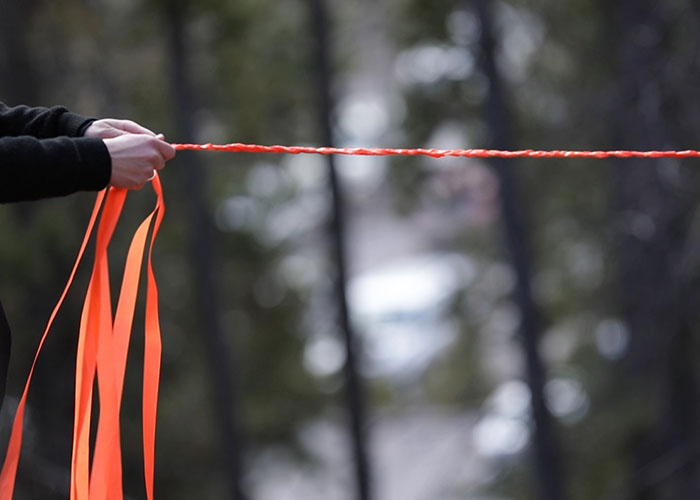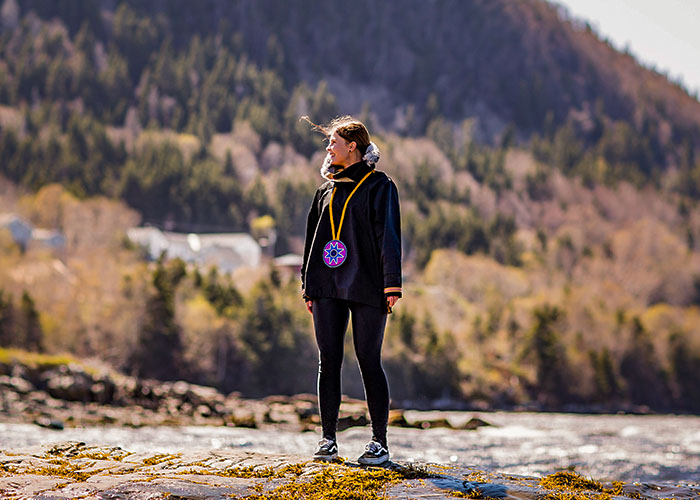INNOVATION AS ADAPTATION
By David Penney

THE EARLIEST MEMORIES of visual art expression come from her grandmother’s sewing room, making dresses and bracelets from leftover fabric. Teenage inspiration was the material culture of skate and snowboards, counterculture brands and progressive design.
Though she has long since left those years behind, Meagan Musseau, BFA’14, is one of Canada’s most exciting young artists because her practice is rooted in place, land and family — and delivered with the tenacious resolve of a street skater.
“Making artwork puts you in a vulnerable place, but that’s why I trust in my process,” said Ms. Musseau. “My production is … the people who I reach out to and those who are part of the journey with me. When it moves from process to artwork into an exhibition, or show, it’s something from inside yourself that’s out there for the whole world to see — whatever world that is. So that can be quite intimidating. I’ve learned to be okay with it because my artwork comes from my voice, my explorations and points of discovery, so, no matter what, it’s a reflection of where I am at that time.”
Since graduating from Memorial’s fine arts degree program at Grenfell Campus, many are following the progress of her journey. Ms. Musseau’s interdisciplinary visual art practice is rooted in her Mi’kmaq ancestry and her home of Elmastukwek within the Ktaqmkuk territory of Mi’kma’ki (Bay of Islands, Newfoundland).
Her work has been shown nationally and abroad, garnering recognition from across the country with awards in 2018 alone that included the VANL-CARFAC Emerging Artist Award and the Atlantic Canadian Emerging Artist Residency at the Banff Centre.
Making artwork puts you in a vulnerable place, but that’s why I trust in my process. My production is … the people who I reach out to and those who are part of the journey with me.
– Meagan Musseau
Using customary art practices and new media, such as beadwork, basketry, land-based action and installation, Ms. Musseau explores memory, language, and the relationship between land and body, object and narrative.
“I think about innovation also as adaptation, so within my practice, I’m adapting to a lot of new materials and technology to explore customary art practices,” she said. “Beadwork, for example, I’ve been beading Mi’kmaq place names onto fuchsia rabbit fur, but the fur is commercially tanned and dyed. It looks unnatural in such a way I that find reflects my generation of materials and expresses my experience, today. It’s bright, bold and demands attention. Our original place names deserve this! I bead language to create a transference through the adaptation of contemporary art materials.”

Ms. Musseau also uses video to create and show performance art. When they poison the bogs we will still braid sweetgrass is a work that comes from a land-based performance on Sacred Buffalo Guardian Mountain in Banff, Alta., in 2017. The piece records her experience of braiding neon orange flagging tape, an expression of cultural practice and knowledge that strives to persist, despite being under siege by a commercial, industrial world.
In order to share that action with a larger public, Ms. Musseau said she worked with a videographer at the Banff Centre, and then used the footage to make a short film.
![Artwork. Meagan Musseau, [re]claim: Elmastukwek. Mi’kmaq place name for Bay of Islands, N.L. Appliqué beadwork on commercial tanned/dyed rabbit fur. January 2018, 12”x17.”
IMAGE COURTESY OF THE ARTIST](http://www.mun.ca/alumni/luminus/online/wp-content/uploads/2019/03/mun-luminus-meagan-musseau-reclaim-series-elmastukwek.jpg)
“Basing myself on the land, opening up into an action, adapting to new technologies and then creating a piece that can be widely disseminated was a big move forward for me. I created a narrative through braiding as an offering to the land. By incorporating synthetic material I opened a dialogue around access to resources and traditional medicines, such as sweetgrass.” Ms. Musseau stated. “I am re-learning history, practising my culture, and adapting to these materials to create expressions of my experiences as a Mi’kmaw woman in 2019. That’s why I feel my practice is innovative.”

